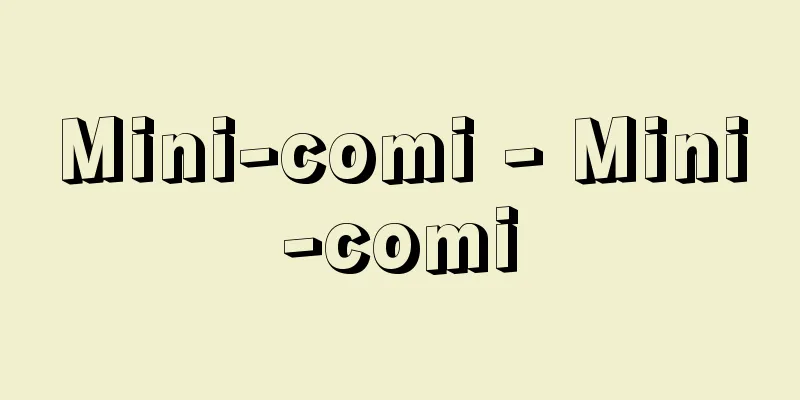Mini-comi - Mini-comi

|
A Japanese abbreviation of mini-communication. It is a general term that includes small magazines, small newspapers, flyers, small publications, and even handmade audiovisual (AV) equipment. It is a Japanese-English word that was born as a counterpoint to the media's criticism of the Security Treaty, which changed its stance from initial criticism to approval during the Security Treaty protests around 1960 (Showa 35). At first, the number of copies was small, it was printed by mimeograph, and the distribution range was limited. However, technological innovation in printing, the development of the light printing industry, and the spread of 8mm films, tape recorders, and video tape recorders broadened the concept of mini-comi. The change was not limited to the form. It also extended to the expression and content. Instead of logic and letters, symbols such as illustrations and gekiga came to be emphasized to express ideals, faith, and the arts. The most drastic change was in the content. It rapidly shifted from politics and social issues to food, sex, and entertainment that are closely related to daily life. In the 1980s, this everyday nature itself became the mainstream of the content of mini-comics, and politics and social issues were swept away by the torrent. At the end of the 20th century, environmental and consumer issues had taken root among residents, and with the spread of word processors and other devices into homes, information magazines became mainstream. [Norio Tamura] OverviewMini-communities have changed with the times, but they have always existed and are becoming more and more important. In Japan, many magazines and newspapers were born during the modernization, but the distinction between mass media and mini-communities was unclear and they were published in a chaotic manner. It was around the time of the Russo-Japanese War (1904-05) that mass media separated from them and formed its own field. In other words, it was a period when mass media became industrialized, individual magazines and newspapers became businesses, journalism was established, and magazines and newspapers became products. Naturally, the editors and reporters who worked there became wage-earning workers. In terms of technology, rotary printing presses and other technologies were introduced. At this time, mini-communities that did not meet either of these conditions were established on the one hand. The mini-communities (as mentioned above, the term had not yet been established) that were launched or became a hot topic around the time of the Russo-Japanese War are historically of high standard. Well-known publications include "Shinkigen," "Chokgen," "Heimin Shimbun," "Tohoku Hyoron," and "Jomo Kyokai Geppo." Jomo Kyokai Geppo was first published in 1898 by Kashiwagi Gien, pastor of Annaka Church in Gunma Prefecture, and although it was a magazine with a circulation of less than 600 copies, its influence was not limited to the Annaka area, but extended throughout northern Kanto. In addition to preaching Christianity, it also spoke about anti-war, the Yanaka Village issue (the Ashio Copper Mine pollution issue), socialism, and other topics, and was banned and fined more than a dozen times. In particular, it repeatedly made courageous statements against the harsh oppression of the Emperor system. The pillar of nonviolent resistance in this mini-comi has not disappeared even after the war, but with the spread of the mass socialization situation, the publishers' own intellectual hunger and inward-looking desire to express themselves have declined. Making mini-comi has become a hobby, and a tendency to waste material money has also infiltrated into mini-comi making. [Norio Tamura] Alternative MediaIn the United States, with the end of the Vietnam War, most of the so-called underground magazines with social criticism disappeared or changed in quality. Examples of magazines that disappeared were Free Press and The Barb, while the one that changed was Village Voice, which was vertically integrated (a form of diversification) into The New York Post and other publications. In their place, magazines that pursue issues such as the environment, homosexuality, and marijuana appeared, but overall they have become more of a pastime. However, in both Japan and the United States, a new type of magazine, information magazine-like magazine rooted in the community, such as town magazines and free papers, has come into its heyday. As magazines have penetrated more deeply into small areas and social groups that are not covered by the mass media, they have come to be called alternative media. Perhaps the situation has changed since the birth of magazines (underground magazines in the United States), and magazines themselves have changed and expanded, and their social role has increased, so it is likely that the term alternative media will be used more in the future. In the new media revolution known as telematics or compunication, new AV equipment such as VTRs, video disks, and VRS (video response systems) are likely to make inroads into alternative media. In addition, with the widespread use of personal computers, mini-communications using the Internet are becoming more and more popular. [Norio Tamura] "The Logic of Mini-Comi - The Restoration of the 'Right to Inform'" edited by Tamura Norio (1976, Gakuyo Shobo)" ▽ "American Town Magazines" by Tamura Norio (1981, Kawade Shobo Shinsha) ▽ "The Contemporary History of Mini-Comi" edited by Maruyama Hisashi (1985, Heibonsha) ▽ "Japanese-Language Newspapers in America" by Tamura Norio (1985, Shinchosha) [Reference] |Source: Shogakukan Encyclopedia Nipponica About Encyclopedia Nipponica Information | Legend |
|
ミニ・コミュニケーションの日本的な略語。小雑誌、小新聞、ちらし、小出版物さらには手づくりのAV(audio visual)機器までを入れた総称。1960年(昭和35)前後の安保闘争のなかで、当初の条約批判から承認に転回したマスコミへの批判を込めて、その対極として生まれた和製英語。最初は部数も少なく、謄写版刷りで、配布範囲も限られたものだった。しかし、印刷の技術革新、軽印刷工業の発展、8ミリ映画、テープレコーダー、ビデオテープレコーダーなどの普及は、ミニコミの概念を幅広くしていった。変化は形式だけではない。表現や内容にまで及んでいる。理念、信仰、学芸を表現するのに論理や文字にかわって、イラスト、劇画などの記号が重視されるようになった。もっとも変化の激しいのは内容である。政治や社会問題から急速に日常生活に密着した食べ物、性、娯楽に移っていった。1980年代はこの日常性そのものがミニコミの内容の主流となり、政治や社会性はその奔流に押し流された時期である。20世紀の末になると、環境・消費者問題が住民のなかに定着したこと、ワープロなどの家庭への普及もあって、情報誌的なものが主流になった。 [田村紀雄] 概観ミニコミは時代とともに変化したが、いつの時代にも存在し、ますます重要なものになってきている。日本でいえば近代化のなかで多くの雑誌、新聞が生まれたが、マスコミとミニコミの区分は定かでなく、混沌(こんとん)と発行されていた。そのなかからマスコミが分離し、独自の分野を形成するのは日露戦争(1904~05)前後である。すなわちマスコミは産業化し、個々の雑誌、新聞は企業として成り立ち、ジャーナリズムが確立し、雑誌、新聞が商品となった時期である。当然そこに働く編集記者は賃金を受け取る勤労者になる。技術的にも輪転印刷機などの導入がみられる。このとき、このいずれの条件をも満たさないミニコミが一方に成立する。日露戦争前後に創刊されたり話題となったミニコミ(前述のように用語は未成立)は、歴史的にも水準の高いものである。『新紀元』『直言』『平民新聞』『東北評論』『上毛(じょうもう)教界月報』などが知られる。『上毛教界月報』は、群馬県安中(あんなか)教会の牧師柏木義円(かしわぎぎえん)によって創刊(1898)され、わずか600部にも満たない雑誌であったが、その影響は安中周辺にとどまらず北関東各地に及んだ。キリスト教を説くだけでなく、非戦、谷中(やなか)村問題(足尾銅山鉱毒問題)、社会主義などに言及し、発禁や罰金の処分は十数回に及んだ。とくに天皇制の過酷な抑圧に対しては勇気ある発言を繰り返している。このミニコミの非暴力不服従の柱は戦後もなくなったわけではないが、大衆社会化状況の浸透によって、発行者自身の知的ハングリーさや内向した表現意欲の減退がみられる。ミニコミづくりがホビー化し、また物質的な濫費(らんぴ)消耗の傾向もミニコミづくりに入り込んできた。 [田村紀雄] オルタナティブ・メディアアメリカでもベトナム戦争の終結を機に、社会批判を伴ったアングラ誌とよばれるミニコミの大半は姿を消すか、変質していった。消えた例は『フリープレス』『バーブ』などであり、変質したのは『ニューヨークポスト』などに垂直的統合(多様化の一形態)していった『ビレッジ・ボイス』である。かわって環境、ホモ、マリファナなどの問題を追及するミニコミが現れたが、全体として風俗化している。ただ日米とも、タウン誌やフリー・ペーパーにみられるような地域に根ざした情報誌的な新しいタイプのミニコミが全盛になったことである。ミニコミが、マスコミのカバーしないような小さな地域や社会集団にとっていっそう深く入ってきているという点で、オルタナティブ・メディアalternative media(もう一つの媒体)という呼び方をするようになった。おそらくミニコミ(アメリカではアングラ誌)が生まれたときと状況が変わり、ミニコミ自身も変化をしながら広がり、社会的役割も高まったことを反映して、これからはオルタナティブ・メディアという用語のほうが使われる可能性が強い。またテレマティークtélématiqueやコンピューニケーションcompunicationとよぶニューメディア革命のなかで、VTR、ビデオディスク、VRS(video response system、画像応答システム)といった新しいAV機器が、このオルタナティブなメディアに激しく入り込んでくることも考えられる。また、パソコンの普及に伴ってインターネットを利用したミニコミも盛んになっている。 [田村紀雄] 『田村紀雄編著『ミニコミの論理――「知らせる権利」の復権』(1976・学陽書房)』▽『田村紀雄著『アメリカのタウン誌』(1981・河出書房新社)』▽『丸山尚編著『ミニコミの同時代史』(1985・平凡社)』▽『田村紀雄著『アメリカの日本語新聞』(1985・新潮社)』 [参照項目] |出典 小学館 日本大百科全書(ニッポニカ)日本大百科全書(ニッポニカ)について 情報 | 凡例 |
Recommend
The Three Treasures - Sanbo no Yakko
To sacrifice oneself as a slave to the Three Treas...
Etawa
...They have a milk production capacity of 600-12...
Urdaneta - Urdaneta (English spelling) Andrés de Urdaneta
1498‐1568 Spanish navigator. Born into an aristocr...
Mondory
...In this way, the "King's Theatre"...
Chara globularis
…[Mitsuo Chihara]. . . *Some of the terminology t...
Bēssos (English spelling)
…The vast amount of precious metal bullion that w...
Aristichthys nobilis (English spelling) Aristichthysnobilis
…It is often called Rengyo together with Aristich...
Danshi paper
Although not commonly used today, this washi pape...
a priori language (English)
…Furthermore, Johann Martin Schleyer (1831-1912) ...
Karl XII - Karl
King of Sweden (reigned 1697-1718). In 1700, he st...
Cavelerius saccharivorus (English spelling) Cavelerius saccharivorus
...They are herbivorous, but some species are als...
farmstead
…This is almost the same as in Germany. (1) Farms...
Aburauo - Oilfish
...A marine fish of the Perciformes family. Its m...
Hayashida [Hot Spring] - Hayashida
This hot spring is located in the middle of Mount ...
Redemption - Onshoku
A criminal privilege in ancient Japanese law. A ty...



![Ochi [town] - home](/upload/images/67cb11ceb8cea.webp)





